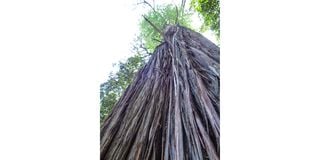Cedar: The tree with great demand, from Africa to Europe and Americas

A worm's-eye view of a cedar tree. The tree has multiple benefits.
What you need to know:
- In Europe and North America where cedar wood is exported to, it is used for the manufacture of pencils and penholders.
- The tree is often used in traditional African medicine. Scientific research has shown that the tree has active compounds that support the traditional uses.
- An infusion of the powdered young twigs is taken as a remedy against intestinal worms. The smoke from the twigs is inhaled as an expectorant.
- Cedar is easily propagated by seed which cost Sh2,000 per kilogramme at Kefri shops. The seeds store well and can be good for at least a year.
Juniperus procera, known in English as African pencil-cedar or Kenya cedar, is a native to mountainous areas in Africa and the Arabian Peninsula.
In Africa, it grows in many countries from Ethiopia in the north to Zimbabwe in the south. In Kenya, its local names include Kumutarakwa (Bukusu), Mutarakwa (Kikuyu), Oltarakwa (Maasai) and Tarkwet (Nandi).
The Turkana call it Ethaiyeiit while the Dorobo and Pokot both call it Teet.
Cedar prefers red to rocky shallow-drained soils in ecological zones whose altitude ranges from 1,500 to 3,000 metres above sea level.
Annual rains range between 800-1,400mm, according to Kenya Forestry Research Institute’s (Kefri) Guide to Planting Trees in Kenya.
Benefits
Cedar has multiple benefits. Its timber is used for building houses, for poles, for furniture and beehives.
According to Plant Resources of Tropical Africa, an online publication of the World Agroforestry Centre, it is also the source of an essential oil and various traditional medicines.
In Europe and North America where cedar wood is exported to, it is used for the manufacture of pencils and penholders.
The oil, which is distilled mainly from sawdust, is used in the cosmetic industry in soaps and perfumes.
Older trees are usually hollow and can be used in making beehives. The wood is widely used for building, joinery, flooring, furniture and all sorts of outdoor work such as roofing, fence posts, water flumes and power transmission poles. It has anti-termite compounds making it ideal for these uses.
It is also suitable for ship and boat building, agricultural and musical instruments and food containers.
Medicine
The tree is often used in traditional African medicine. Scientific research has shown that the tree has active compounds that support the traditional uses.
The essential oil obtained from the leaves has shown anti-oxidant activity. The leaves and bark contain chemicals with anti-bacterial activity.
An ethanol extract of the bark has been shown to inhibit implantation of the foetus. Macerations of the bark are drunk, and also applied as a vaginal wash, to act as birth-control agents.
An infusion of the powdered young twigs is taken as a remedy against intestinal worms. The smoke from the twigs is inhaled as an expectorant.
Applied externally, people with rheumatism are treated by exposure to the smoke of burnt twigs and seed cones.
A hot bath to which the leaves are added is used in the treatment of fever.
Soil conservation
Since cedar can grow in extreme conditions, it is replanted in deforested areas as a means of soil conservation or improvement, and also for erosion control.
However, it is not good for intercropping as leaves from the tree make the soil acidic.
Propagation
Cedar is easily propagated by seed which cost Sh2,000 per kilogramme at Kefri shops. The seeds store well and can be good for at least a year.
The seed may benefit from scarification before sowing to speed up and improve germination. This can usually be done by pouring a small amount of nearly boiling water on the seeds and then soaking them for 12-24 hours in warm water.
Alternative methods of scarification include pre-treatment with concentrated sulphuric acid or scorching the seeds. Seedlings are ready to be planted out when one or two years old and 15-25cm tall.
Wildlings are also used for planting. Young seedlings are light demanding and intolerant of any decomposing organic matter covering the ground.
Therefore, the seeds can only germinate freely in open, grassed areas where there is adequate light and mineral soils. The tree matures in 60 to 100 years.




